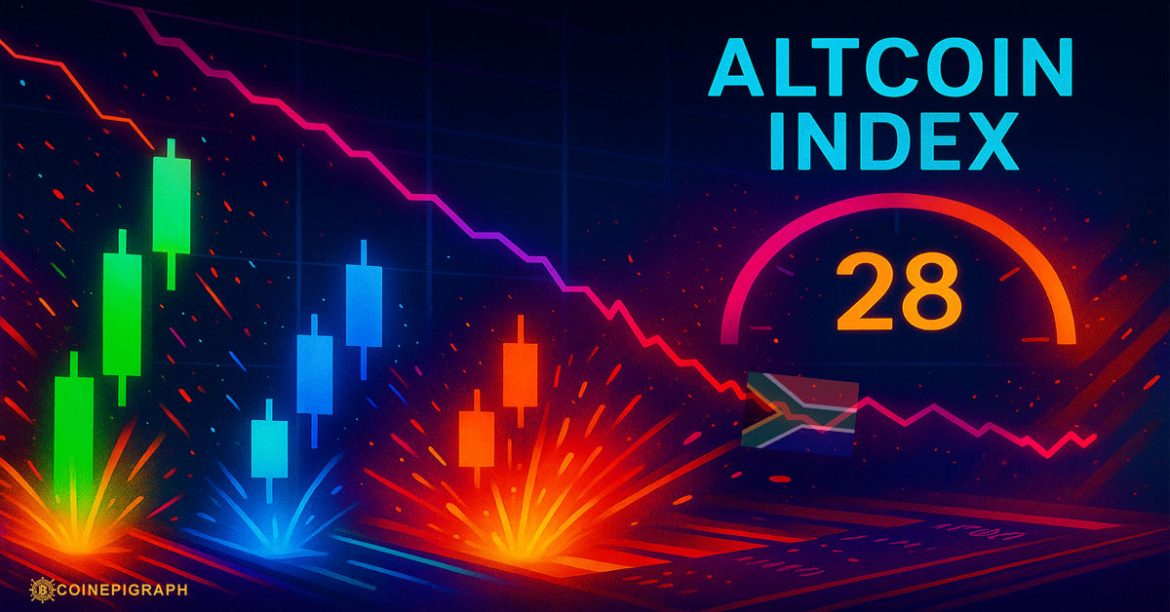By CoinEpigraph Editorial Desk | October 16, 2025
A Cautious Market, but Not a Silent One
The Altcoin Season Index has fallen to 28, signaling a retreat from broad altcoin momentum and a return to Bitcoin dominance. Yet beneath that surface cooling, certain tokens are quietly diverging from the pack—DeXe is advancing, Tron is stabilizing, and Jupiter is seeing renewed network activity. It’s the kind of mixed market that fuels debate: is this the end of an altcoin push, or the early accumulation phase before a broader rotation?
This divergence between sentiment index and selective strength is a hallmark of transition periods—where markets test conviction rather than celebrate rallies. While an index reading below 30 typically suggests risk-off conditions for altcoins, it also reflects a stage where capital begins probing structural narratives rather than chasing momentum.
What the Altcoin Index at 28 Signals
The Altcoin Season Index, often used as a sentiment proxy, measures how many altcoins are outperforming Bitcoin over 90 days. A reading of 28 implies the market is still rewarding Bitcoin over the wider field, favoring liquidity and certainty over exploration.
This often occurs in one of two phases:
- Post-Exuberance Cooling – capital consolidates around Bitcoin before rotating again.
- Pre-Expansion Accumulation – early positioning begins in tokens with clear catalysts.
The key is not the index itself, but whether money is truly leaving the altcoin space—or quietly repositioning within it.
DeXe: A Governance Outlier Defying Sentiment
DeXe (DEXE) has emerged as one of the few tokens pressing upward despite broad index weakness. As a protocol focused on decentralized asset management and governance automation, DeXe benefits from institutional interest in on-chain strategy rails, not hype cycles.
Recent protocol updates and treasury governance discussions have attracted deeper liquidity participants rather than speculative momentum. That alone distinguishes DeXe in a cooling environment—strong governance tokens historically bottom before retail narratives rediscover them.
Tron: Stability Over Speculation
Tron (TRX) has not surged—but it hasn’t broken either. Tron’s chart reflects capital preservation rather than discovery. In periods where liquidity drains from high-beta assets, chains with stable fee revenue, consistent stablecoin flows, and active transaction throughput tend to attract patience over ambition.
Its steady performance while the index falls implies risk management behavior, not total retreat. Where traders once sought trends, some are now seeking survival—and Tron’s network economics provide that foothold.
Jupiter: Activity Rejoins Narrative
Jupiter (JUP), tied to the Solana ecosystem’s trading infrastructure, is seeing a revival in on-chain activity. Swapping volumes, governance interactions, and integrations have triggered interest, but not yet price expansion—an important distinction.
In past cycles, activity-led tokens were first to recover once the liquidity tide returned. Jupiter’s uptick suggests attentive capital is tracking infrastructure, not influencers. Ethereum’s 2020 DeFi wave began the same way—through invisible accumulation before aggressive bidding.
Divergence Beneath the Surface
Even as the index falls, microstructure tells a different story:
| Token | Behavior Signal |
|---|---|
| DeXe | Governance accumulation |
| Tron | Stability / Safe harbor |
| Jupiter | Infrastructure reactivation |
This split implies the early stage of capital sorting, not capitulation. When altcoin cycles mature, markets stop treating all tokens equally. Sector strengths begin to matter—governance, infrastructure, revenue—all increasingly prioritized over meme volatility.
Rotation or Rejection?
A sub-30 index invites two interpretations:
- Bearish Interpretation: Altseason is over; Bitcoin resumes macro control.
- Strategic Interpretation: Smart capital is surveying foundations before repositioning.
Historical context suggests the latter often precedes the former. In Q4 2020, the index fell to similar levels just before capital rotated into DeFi blue chips. The same pattern repeated before Layer-1 and Layer-2 expansions.
👉 “The CoinEpigraph Bottom Line”
An altcoin market with an index at 28 is not a party—it’s an interview. Protocols are no longer graded on narrative enthusiasm but on operational credibility. DeXe, Tron, and Jupiter are the first to answer those questions with activity rather than adjectives.
Altseason may not be here—but neither is surrender. And for those who study early positioning rather than late euphoria, this is where altcycle stories are born, not celebrated.
At Coinepigraph, we pride ourselves on delivering cryptocurrency news with the utmost journalistic integrity and professionalism. Our dedicated team is committed to providing accurate, insightful, and unbiased reporting to keep you informed in the ever-evolving crypto landscape. Stay tuned as we expand our coverage to include new sections and thought-provoking op-eds, ensuring Coinepigraph remains your trusted source for all things crypto. -Ian Mayzberg Editor-in-Chief
The team at CoinEpigraph.com is committed to independent analysis and a clear view of the evolving digital asset order.
To help sustain our work and editorial independence, we would appreciate your support of any amount of Bitcoin/Satoshi to this address below: 3NM7AAdxxaJ7jUhZ2nyfgcheWkrquvCzRm
and through our Support Page.
🔍 Disclaimer: CoinEpigraph is for entertainment and information, not investment advice. Markets are volatile — always conduct your own research.
COINEPIGRAPH does not offer investment advice. Always conduct thorough research before making any market decisions regarding cryptocurrency or other asset classes. Past performance is not a reliable indicator of future outcomes. All rights reserved 2024-2025.




